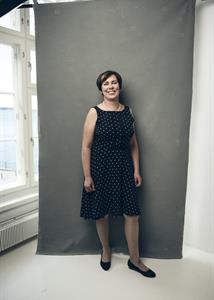Everyone wants to know what Tekla Tammelin (D.Sc. (Tech)), Research Professor in Biomaterials Engineering and Design, thinks about cellulose’s potential for development. Can it solve the microplastics problem or replace oil-based textiles? Could it be used in the production of mobile phone parts?
Tammelin is a successful surface chemist, whose groundbreaking studies have garnered interest the world over. She is VTT Research PI (Principal Investigator) of the FinnCERES flagship Competence centre of VTT and Aalto University, which studies, among other things, lignocellulose and nanocellulose-based material solutions. The programme is massive: it involves 80 scientists and several companies, Metsä Fibre among them.
“Cellulose is a multidimensional material. It forms the entire backbone of a plant, and its function is very broad. Cellulose is also adaptable. The most fun aspect of it all is that it’s a very responsive material, particularly in terms of water. If the water doesn’t travel, the plant dies. Using this idea in material sciences is a great opportunity.”
Cellulose is a biomaterial, which works like plastic
One of the most interesting research subjects at the moment is nanocellulose, which Tammelin has been working on for ten years.
Nanocellulose offers a multitude of possibilities for combatting climate change. It can be used in the purification of air and water. Films made from nanocellulose could prevent microplastics going down the drain from a washing machine. They could also facilitate the recovery of gold, silver, copper and heavy metals from drinking water.
“When she was working on her doctoral dissertation, Minna Hakalahti, a former member of my research team, calculated that a square metre of nanocellulose film could capture enough gold for a small gold ring.”
Tammelin is happy that there are discussions in Finland about investment in new more environmentally-friendly bioproduct units.
Besides, wood is not the only material from which you can make pulp. It could also be made from biomass side streams and annual crops such as grains.
“Cellulose is the new plastic. Its potential as both a replacement for old materials and an enabler of new applications is recognised.”
The next step is to use cellulose molecules and structures in optoelectronics, lenses and light refraction. They could be used in, say, verifying the authenticity of banknotes and medicine packaging.

Surface chemistry in forest product technologies is not just playing with numbers
Even as a child, Tammelin was encouraged to study natural sciences. Her father was a biologist and teacher, and her mother was a kindergarten teacher.
“I’m probably slightly competitive, and I do have ambitions, but I haven’t resorted to elbowing or blood, sweat and tears to advance my career.”
Tammelin initially studied process chemistry at the Espoo-Vantaa Institute of Technology and began working as a research assistant in the team led by Professor Per Stenius at Helsinki University of Technology.
“I got into the surface and colloid chemistry team in forest product technologies. I was instantly carried away, because the team was led by Professor Stenius. He’s a brilliant surface chemist.”
After completing her engineering degree she soon landed the post of a research engineer at the school and is still on the same path.
Has she experienced any prejudices as a woman?
“I haven’t thought about any glass ceilings, even though I work in a largely male environment. But this too has changed, and our team now includes an equal number of women and men. When I’ve done my work well, I’ve been encouraged and have moved forwards in my career.”
According to a recent study, the number of girls who pursue a career in natural sciences is still pretty low. Tammelin suggests cooperation between schools and research institutions as a solution to this problem.
“We should go to schools and day-care centres to offer information. For example, the city of London has made a commitment to science education, and my colleagues there hold a lot more public events. It’s important for children and young people to know about the options available to them. Mathematics is a lot more than just number crunching.”

